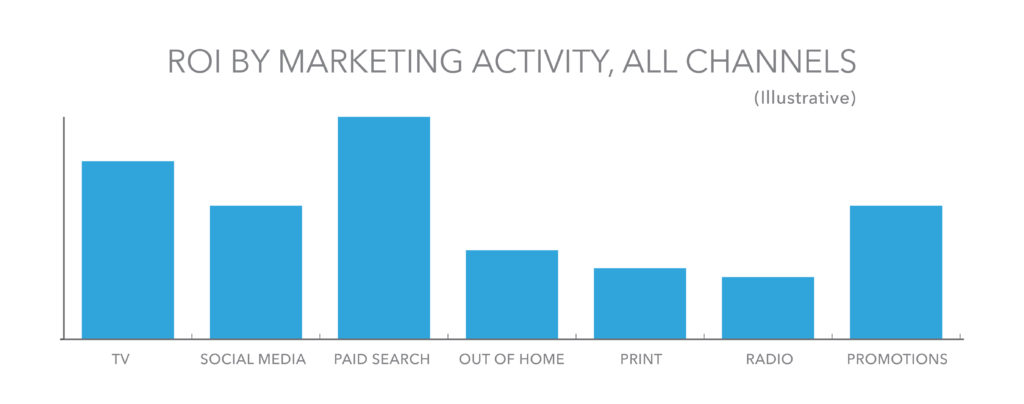“Marketing is more of an art than a science.”
“Marketing spend is an expense, not an investment.”
If these sentiments sound familiar, rest assured you are not alone. While marketing is often one of the larger components of a company’s overall budget, it is also sometimes the least understood outside of the marketing function. As a member of your company’s finance leadership team responsible for major financial decisions across the company, you possess a good understanding of other functions such as operations, supply chain, manufacturing or procurement. You also have proven and well-established techniques such as Discounted Cash Flow Analysis (DCF), Net Present Value (NPV) and Internal Rate of Return (IRR) to analyze the returns and profitability of projected investments in these functions. However, with marketing, this is not always the case.
That fuzzy realm beyond numbers and metrics …
While most non-marketing professionals believe that marketing works and is necessary, they don’t always have a good understanding of how it works. They often view marketing as a function where decisions are driven more by intuition and gut feel, rather than by the hard data, numbers and empirical evidence they are used to. While other functions have ways to estimate or measure the effectiveness of investments, such measures for marketing are not well known or widely known. The metrics that marketers quote – click thru rates, conversion rates, engagement, brand awareness etc. – don’t help either. These, again, are completely foreign to most outside the marketing function. This is especially true for finance professionals, used to the specificity of measures like Return on Investment (ROI).
And therein lies the problem. CMOs and marketers on the one hand, and finance decision-makers on the other, just do not speak a common language. Consequently, finance professionals don’t have the tools and methodologies to scrutinize marketing expenditure and measure accountability, the way they would with every other spend they oversee in a company. And that’s not an ideal situation for either function.
Marketing Mix Modeling: Translating marketing to the language of finance
Marketing Mix Modeling (MMM) is an analytical technique that looks at the historical relationship between marketing spending and sales to determine how each marketing activity has impacted performance. The learnings are then adopted to adjust marketing tactics and strategies to drive maximum growth. As such, MMM is the perfect solution to help “translate” marketing expenditures to a language that both you and your CMO can understand. Here are 3 things about MMM you need to know (and should love)!
1. MMM speaks ROI
MMM defines the effectiveness of each marketing activity like TV, print or out-of-home advertising, digital marketing, promotions etc. in terms of its contribution to sales or revenue and provides planning and simulation tools to decide on the optimal allocation of future budgets. In other words, it not only helps in measuring the ROI of every marketing expenditure, but also assists in maximizing ROI – enabling exactly the kind of data-driven investment decisions that you, as a financial decision-maker, are familiar and comfortable with. Simply put, a robust MMM solution gives you the confidence to trust marketing spend decisions.

2. MMM is ‘always-on’
Unlike traditional MMM solutions that took months to generate insights (often based on outdated data), current MMM solutions continuously measure the effectiveness of marketing activities and campaigns, allowing marketers to tweak spending in near real-time. For you, this means an ‘always-on’ and proactive approach to managing marketing expenditures and maximizing sales, revenues and ROI. It allows you or your Marketing Controller to ask specific questions (e.g. is this campaign doing as well as expected? should we reduce spending on advertising and invest more in promotions?) and your marketing team to provide specific, accurate, data-based answers to help maximize growth.
3. MMM is in-house and on-demand
Today, MMM can be deployed in-house and on-demand making it faster, cheaper and easily scalable. This means it can be run more frequently and for more of your company’s brands and markets, rather than limiting it to just the biggest ones, on account of cost and time constraints. This makes ROI-focused decision making and optimization possible for a larger part of your overall budget, contributing to your Key Performance Indicators (KPIs) and growth objectives.
For these reasons, Marketing Mix Modeling can be a useful ally that helps the marketing team and the finance team speak a common language, work more closely together and align both your priorities with business objectives. MMM correctly deployed can add up to 10% top-line growth to the business through more efficient and effective marketing spending. And that’s something worth taking a closer look at. If MMM is a technique you are not yet familiar with, get together with your Marketing Controller and CMO and speak to us to find out how it can help you achieve faster, more responsive marketing decision making that maximizes ROI.
Analytic Edge’s Demand DriversTM solution offers brands the ability to run MMM and other predictive analytics in-house, delivering an ‘always-on’ view of the marketing effectiveness of your various marketing channels. Demand DriversTM is already used by numerous global brands to achieve faster and more measurable marketing decision making.

